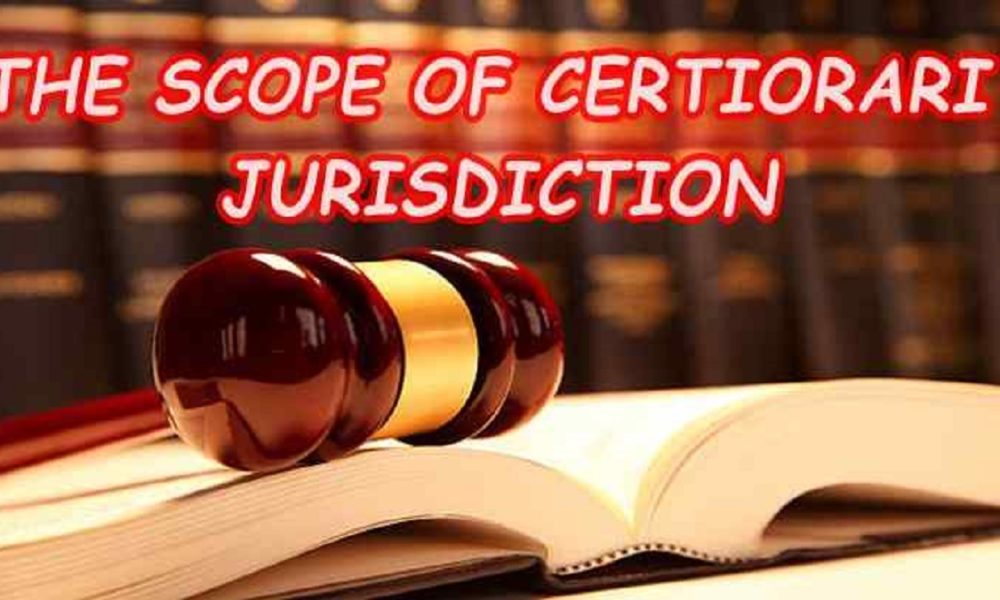Nobody had ever doubted that an order in the nature certiorari could not be issued to an inferior court exercising civil or criminal jurisdiction until the aforesaid issue was raised and the correctness of the decision of the Supreme Court in Surya Dev Rai’s [AIR 2003 SC 3044] case was questioned and in Radhey Shyam v. Chhabinath [(2015) 5 SCC 423] (hereafter “Radhey Shyam’s case”). The judgment of the Supreme Court of India in Radhey Shyam has now finally decided this question by stating that order of the subordinate court cannot be challenged by seeking writ of certiorari under Article 226 of the Constitution. This judgment has divested the High Court in India of its power to examine and quash any order passed by subordinate courts by issuing an order in the nature of certiorari. The judgment, however, does not make it clear whether any other order or direction viz. order in the nature of prohibition or mandamus can be issued by the High Court to the subordinate court under article 226 of the Constitution of India. Be that as it may, now in view of this judgment, where against any order passed by the subordinate court no appeal, revision or review is provided for in the statute, the only option left for the litigant is to invoke the power of superintendence under Article 227 of the Constitution of India.
Ratio of Radhey Shyam’s case
Radhey Shyam’s decision holds that judicial orders of civil court are not amenable to writ jurisdiction under Article 226 of the Constitution. For the aforesaid conclusion the Supreme Court in para 11,21 states : “No direct decision of this Court except Surya Dev Rai has been brought to our notice where certiorari may have been issued against the order of a judicial court. There are no precedents in India for High Courts to issue writs to subordinate courts”
In Para 12 and 13 it states that judicial orders cannot be challenged as violating fundamental rights under Articles 14 and 19 and for this proposition of law the Supreme Court’s decisions in Ujjambai [AIR 1962 SC 1621] and Naresh[ AIR 1967 SC 1] have been referred to and relied upon. In Para 21 it states “a writ of certiorari lies against patently erroneous or without jurisdiction order of Tribunals or authorities or courts other than judicial courts.”
The aforesaid conclusion that judicial orders of civil court are not amenable to writ jurisdiction under Article226 of the Constitution recorded in Radhey Shyam’s case is not legally sound and requires reconsideration for the following reasons.
Nature of Certiorari
Without delving deep into the history of certiorari and its uses suffice it to state that Certiorari is an original writ issuing out of Chancery, or the King’s Bench, directed in the King’s name, to the judges or officers of inferior courts, commanding them to return the records of a cause pending before them, to the end the party may have the more sure and speedy justice before him or such other justices as he shall assign to determine the cause.” Certiorari is a writ issued from a superior Court to an inferior Court or Tribunal. The underlying policy is that all inferior Courts and authorities have only limited jurisdiction or powers and must be kept within their legal bounds. Quashing and prohibiting orders are primarily for the control of inferior courts, county courts, justices of the peace, coroners and all statutory tribunals. The order (in the nature of certiorari) cannot be directed by the High Court to any tribunal which is a branch of the High Court for the purpose of quashing its proceedings, but it may issue to the crown court although it is a superior court. In the nineteenth century the writs came to be used also to control the exercise of certain administrative functions by local and central government authorities which did not necessarily act under judicial forms or bodies exercising judicial or quasi-judicial functions[ Rayot of Garbandho’s case AIR 1943 PC 164 ]. Certiorari will lie although a right of appeal has been conferred by statute.
Certiorari cannot be taken away by law
It is firmly established position of law that certiorari cannot be taken away by law except by express negative words, therefore, a fortiori it cannot be ousted by judge made law. In Annie Besant v. Advocate General [AIR 1919 SC 31] the Privy Council made the following observations on the effect of an ordinary legislation on the certiorari jurisdiction:
“Section 435 of Cr.PC and Section 115 of CPC 1903 are not exhaustive. Their lordship can imagine cases, though rare ones, which may not fall under either of these Sections. For such cases, their lordships do not think that the powers of High Courts, which have inherited the ordinary and extraordinary jurisdiction of the Supreme Court to issue writs of certiorari, can be said to have been taken away.”
The aforesaid paragraph means that the power of certiorari is a power which the High Court possesses in addition to its power of supervision and revision under s.115 of CPC and s.107 of GOI Act. The basic structure doctrine also does not permit taking away or giving a restricted interpretation to the power of judicial review vested in the high court under Article 226. [L. Chander Kumar AIR 1997 SC 1125]
Constituent Assembly Debates:
During the Constituent Assembly debates also the issue was considered whether the writs should be incorporated by their name in the constitutional provisions of Article 32 and Article 226 and the Assembly thought it proper to make a special reference of the prerogative writs in the aforesaid articles so that by an ordinary law Parliament cannot take away these writs or dilute their amplitude. Dr. Bakshi Tekchand in Constituent Assembly at the time of discussion of Draft Article 202 (Now Article 226) suggested to equip every high court with the jurisdiction to issue certiorari outside the territorial limits of town and to make it available in mofussil also. He gave a specific example saying that prior to the Constitution if a particular proceeding was pending in the court of Trichonapoly or Madura, the High court of Madras had no jurisdiction to issue writ of certiorari to such courts because of the language of the charter by which the high court was established. He therefore suggested that such a restriction should be removed.
Naresh’s case grossly misunderstood
Naresh’s case heavily relied upon in Radhey Shyam’s case is not an authority for the proposition of law that certiorari cannot be issued to any subordinate court. Naresh’s case simply states that the order of the High Court cannot be subject matter of a petition under Article 32 before Supreme Court and that one Superior Court of record cannot by issuing certiorari quash the order of another superior court of record. In Naresh’s case whether writ of certiorari can be issued to the subordinate court did not arise. Some passing observations in the judgment of Naresh’s case cannot be said to be the ratio decidendi of the case. In fact in that very case the Supreme Court cautioned that while interpreting constitutional provisions the court should not make observations on the points not directly arising in the case. The Supreme Court has time and again said that judges were not authorized to make disembodied pronouncements on serious and cloudy issues of constitutional policy without battle lines being properly drawn vide Sanjeev Coke’s case AIR 1983 SC 239. Moreover, Naresh’s case Para 63 does not seem to have correctly stated the statement of law on the scope of certiorari. It is noticed that in Naresh’s case Halsbury’s Laws of England 3rd Edition of year 1953 had been referred to. However, by the time in Naresh’s case the reference of the Halsbury’s Laws of England 3rd Edition, Year 1953 was made, the law on this issue was already clarified in R. v. Judge Hurst, Ex parte Smith [1960] 2 All E R 384 and R v. Judge Worthington ex parte Madan [1960] All E R 457. Accordingly Halsbury’s laws of England, 4th Edition, year 1976 clearly states that the county court which is an inferior court of civil jurisdiction is subject to certiorari.
Certiorari and prohibition are not issued for protecting fundamental rights:
It is not a matter of debate that the judicial or quasijudicial order ordinarily cannot violate fundamental rights [Refer to Naresh’s case and Roopa Hurra’s case]. The purpose of the writs of certiorari and/or prohibition is to review and correct the defect of jurisdiction or an error apparent on the face of the record or to quash any order passed in violation of substantive or procedural law or in violation of the principles of natural justice. Thus, writs of certiorari or prohibition is issued for “any other purpose” as stated in Article 226 and hence, the requirement of violation of fundamental right and that the respondent in such a proceeding is whether “State” or not within the meaning of Article 12 of the Constitution of India is hardly relevant.
No reference of “court” or “tribunal” in Art.226 not significant:
The fact that in Article 226 the words “court” or “tribunal” have not been used is not a pointer to hold that Article 226 does not empower the high court to issue certiorari to subordinate courts since the words “authority and government” are specifically used which will cover “Court” and “tribunal” within its ambit. In a wider sense the court is also an authority invested with powers to adjudicate a lis, summon witnesses for production of documents, discovery etc., pronounce and execute its judgment/order. The word “government” in Article 226 also covers all three wings of government viz. executive, legislature and judiciary, within its ambit. The words “Court” and “Tribunal are not mentioned in Art.226 as the framers of the Constitution wanted to confer much wider power on the High Court. This article never intended to circumscribe the judicial control by High Court in the form of certiorari by excluding courts or tribunals from the preview of certiorari. Be that as it may, there is sufficient intrinsic and historical evidence available to conclude that certiorari is meant to quash the decisions of the inferior courts of civil or criminal jurisdiction.
Article 227 not a substitute for ‘certiorari’ under art 226
Due to certain Amendments in CPC the scope of revision is restricted to such an extent that for correcting the errors of law apparent on the face of record in the order of the inferior courts or where an order is passed in violation of a substantive or procedural law or principles of natural justice there is no other remedy except approaching the High Court under article 226 of the Constitution of India. Article 227 is not a legal remedy in the strict sense. It recognises residual power of superintendence in the High Court besides revision jurisdiction under ordinary law. Article 227 of the Constitution of India can be invoked in very rare cases where the proceedings of the inferior court is without jurisdiction [Refer to Waryam Singh’s case AIR 1954 SC 215]. Article 227 cannot be used as a substitute of certiorari under Article 226.
Conclusions:
Thus, from the above discussion it is clear that certiorari was invented to exercise judicial control over subordinate courts and that there are number of instances where certiorari was issued to magistrates, justices of the peace, county courts, crown courts In England. Nobody had ever doubted that certiorari could not be issued to inferior court exercising civil or criminal jurisdiction. In fact the use of certiorari was expanded to cover administrative or quasi-judicial decision also. It is true that during this period many statutes were enacted in England and India investing the High Court and some other courts with judicial control in the form of appeal, revision and review over the subordinate courts and, therefore, the instances of issuing writ of certiorari to inferior courts gradually dropped materially. However, during last sixty years all petitions challenging any order (not subject to appeal or revision) of a subordinate court invariably were being filed under Article 226 and/or Article 227 vide Hari Vishnu’s case AIR 1955 SC 233. It would be, however, incorrect to hold that certiorari cannot be issued to subordinate civil or criminal courts of primary jurisdiction. In fact in the case of Annie Besant (supra) the Privy Council it was held that certiorari would lie against the order of inferior courts of civil or criminal jurisdiction where an order of such courts is neither appealable nor revisable under CPC or Cr.PC.
There is ample evidence available in England and India that certiorari is issued to inferior courts of civil and criminal jurisdiction.
In neither Naresh’s case nor in Radhey Shyam’s case the decision of the Privy Council in Annie Besant’s case AIR 1919 PC 31 was brought to the notice of the Supreme Court where it was held that certiorari would lie against the orders of subordinate court of civil and criminal jurisdiction in respect of orders that are not revisable under CPC or CrPC.
Naresh’s case Para 63 has not correctly stated the law on certiorari. It clearly emerges from the facts recorded that in Naresh’s case Halsbury’s Laws of England, 3rd Edition of year 1953 was referred to and relied upon. However, by the time the reference of the Halsbury’s Laws of England, 3rd Edition, Year 1953 was made in Naresh’s case, the law on this issue was already clarified in R. v. Judge Hurst, ex parte Smith and R v. Judge Worthington, ex parte Madan. Accordingly Halsbury’s laws of England, 4th Edition, year 1976 clearly states that county courts which is an inferior court of civil jurisdiction is subject to certiorari.
Naresh’s case ratio is that the Supreme Court under Article 32 cannot issue writ of certiorari to quash the decision of the High Court and that usually orders of any court exercising judicial power cannot violate the fundamental right of a person. Naresh’s case nowhere decides that certiorari cannot be issued to subordinate court. The reproduction of a footnote from Halsbury’s laws of England 3rd Edition, Year 1953 is not the ratio of the case.
In none of the cases referred to and relied upon by the Supreme Court in Radhey Shyam’s case the issue was directly or indirectly raised about High Court’s power to issue writ of certiorari to subordinate court or inferior court.
The conclusions of the Supreme Court in Radhey Shyam’s case that there is no evidence of certiorari being issued to subordinate courts is erroneous. This reasoning cannot be described to be sound. A constitutional issue cannot be decided on the reasoning that there is no precedent brought to the notice of the court where writ of certiorari was issued to the subordinate court.
Certiorari can only be taken away by express negative words and not otherwise.
The very purpose for which the writ of certiorari was evolved is to control subordinate courts only but with the passage of time it was made available to quash the orders passed by quasijudicial authorities and persons discharging functions of judicial nature. This would however not mean that the original purpose and the principal object of certiorari as a tool to control inferior courts was lost.
Article 227 is neither a substitute for “certiorari” nor a legal remedy stricto sensu but just a residual power of superintendence which cannot be invoked in a routine manner.
Sr. Adv. Asim Pandya practises at the Gujarat High Court.







